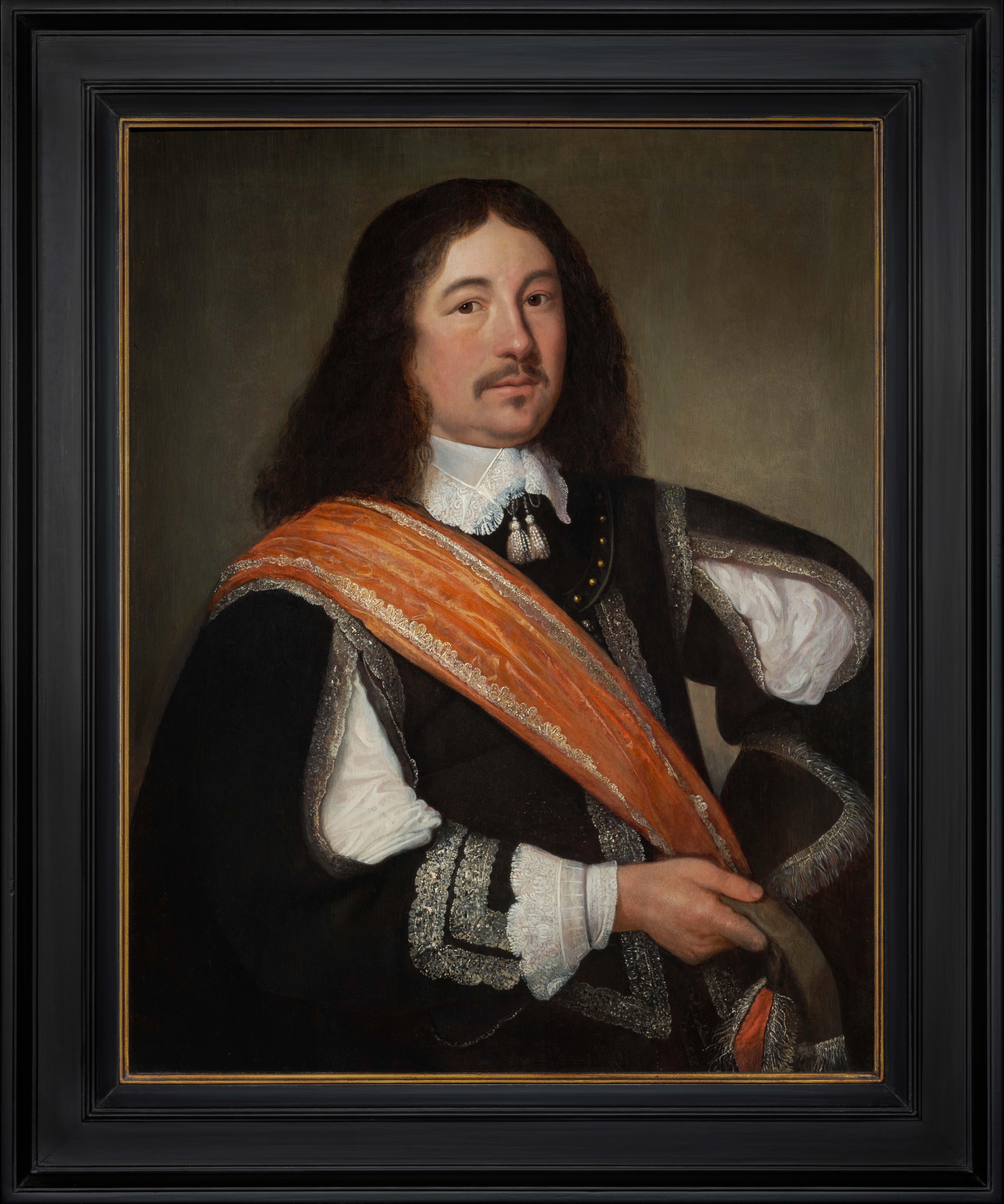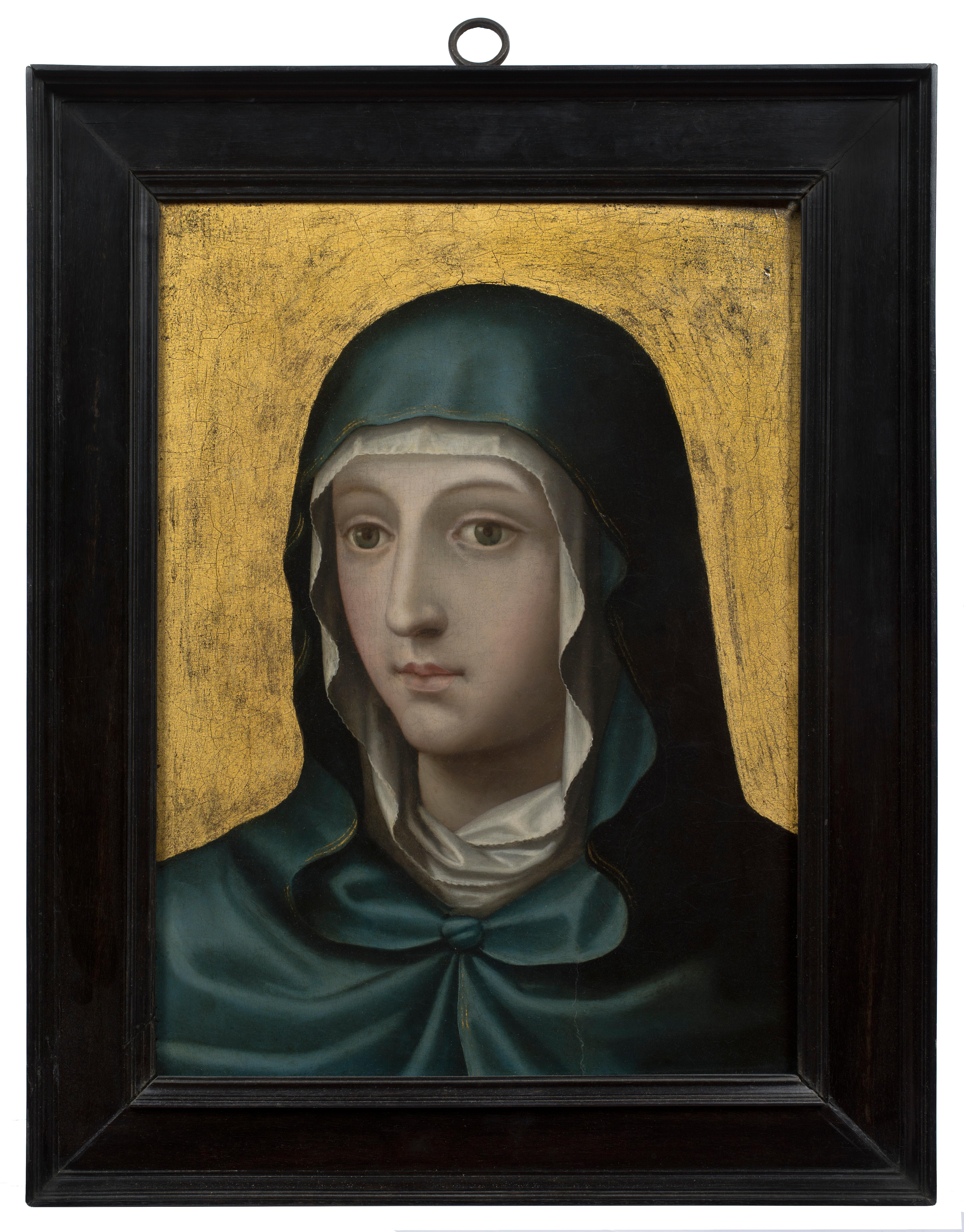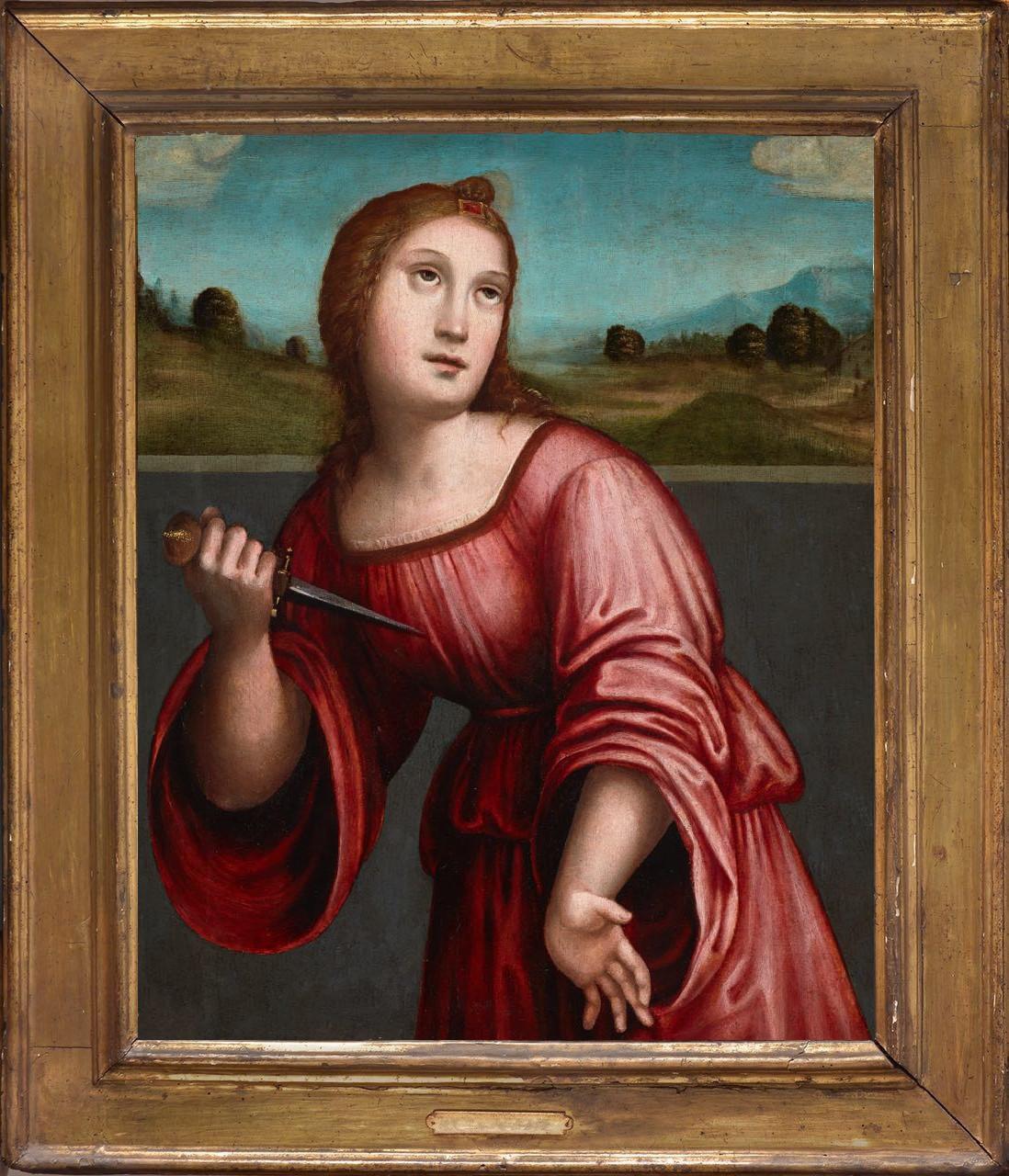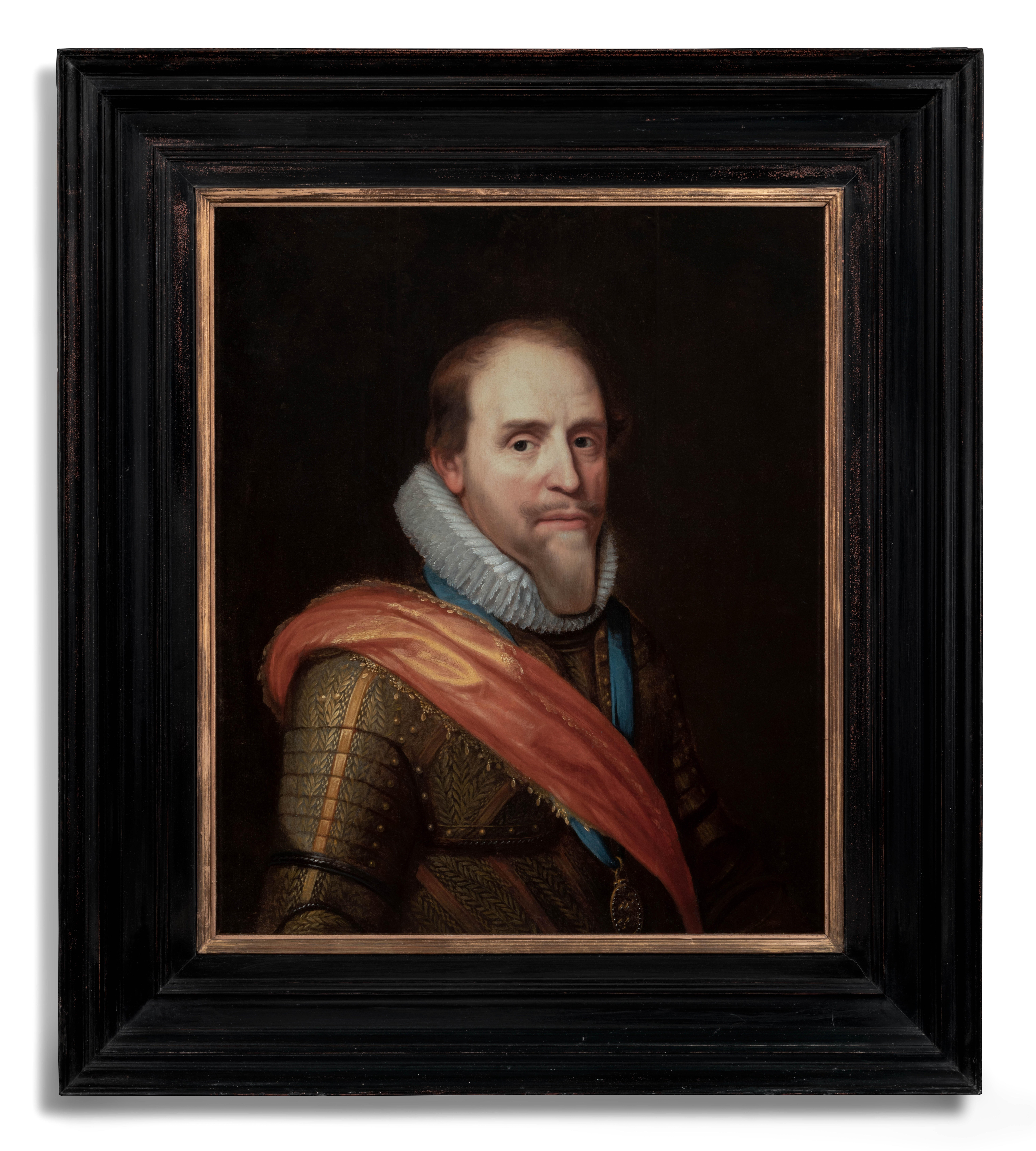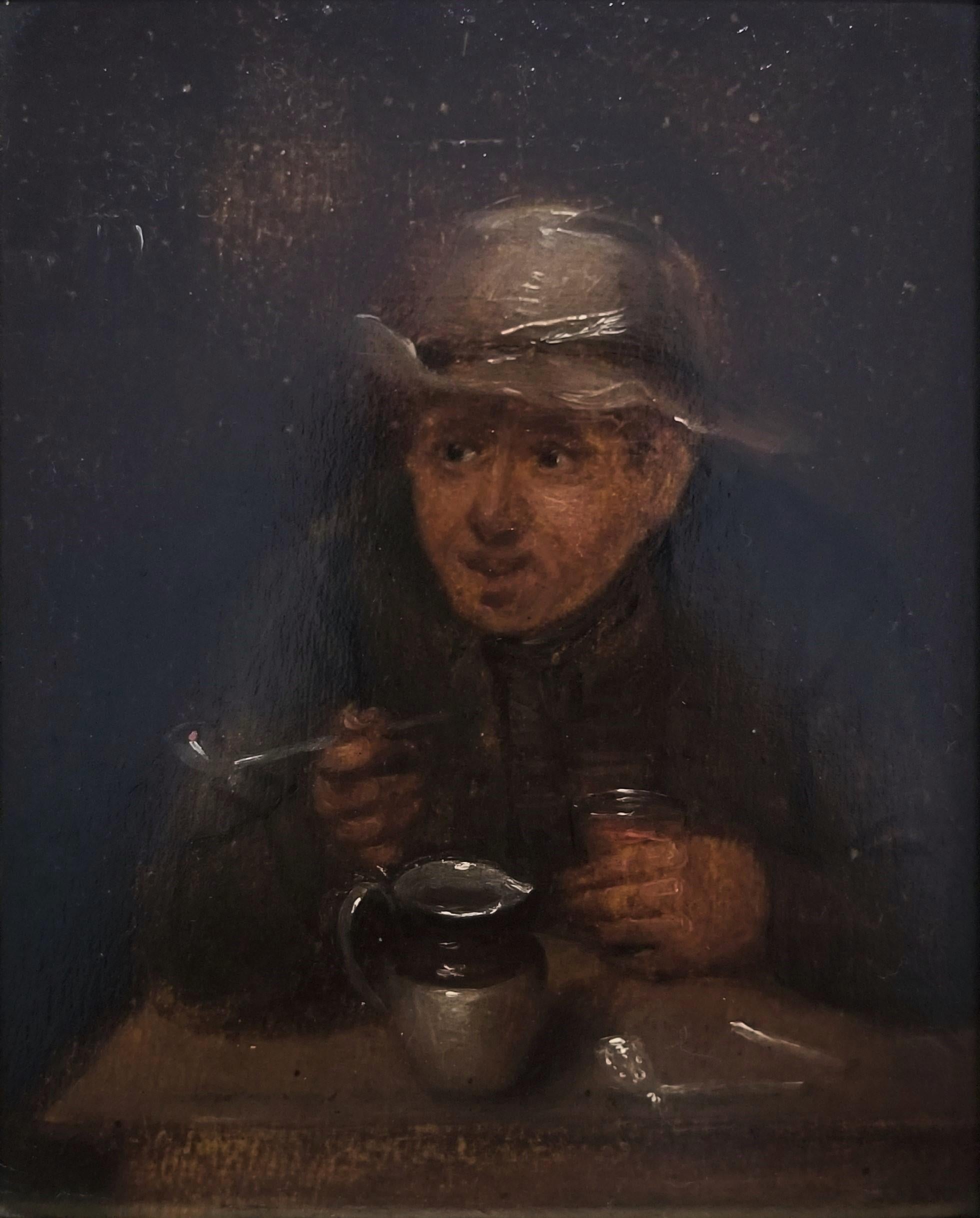Items Similar to The Pearl Lady, Oil on board signed Honthorst, dated 1644
Want more images or videos?
Request additional images or videos from the seller
1 of 11
Gerard van HonthorstThe Pearl Lady, Oil on board signed Honthorst, dated 1644 1644
1644
About the Item
The Pearl Lady, most probably Elisabeth of Bohem, Princess Palatine.
Oil on board signed Honthorst, dated 1644
Within a beautiful tortoise shell
With a certificate by René Millet ( Well Known French Expert in Paris)
The young unknown portrait shows the talent of the artist. We will appreciate the quality of glazed face, the light in the beads and the psychological analysis of the model. We almost read the character of the model. This type of face is found throughout the valley of the Rhin, Switzerland, the Netherlands.
Our beauty is flirtatious and love beautiful pearls, symbol of fidelity. And so the large barocco pearl, the earrings, the necklace, the adornment in her hair; all attest of the prosperity.
Gerrit Van Honthorst was born in 1590 and died 1656.
His career is divided into two very different parts.
In the first part of his life he is The “Night Master”, "Cavaragesque" painter, that the Italian nicknamed GUERARDO OF THE NOTTE. This period mainly Roman, which will influence LA TOUR and REMBRAND overshadowed the rest of his work.
Indeed, it has been forgotten today; but when GUERARDO DE LA NOTTE returned to Utrecht, he became a fashionable portrait's painter. Radical changes without knowing the real reasons although it is often forgotten that a painter like everyone needs to survive ... Especially since the death of Van Dyck has opened the road to our artist who will rush into exploiting it. He is called to the court of Charles I, in London, where he will paint the king and the nobles of the court. In 1637, he moved to The Hague and become Van Dyck's official successor for the Netherlands and all Europe.
Gerrit van Honthorst’s night paintings caused such a sensation in Rome that he was known as Gherardo delle Notti (Gerard of the Night Scenes). An Utrecht native and son of a painter of tapestry cartoons, Honthorst’s reputation was made with these nocturnal pictures, usually religious subjects. A single candle served as the light source whose rays were shielded by the figures. The lighting was derived from Caravaggio’s works, and Honthorst’s role in bringing knowledge of Caravaggio and his followers to the North was critical; many painters, including Rembrandt van Rijn and Georges de la Tour, were influenced by Honthorst’s Caravaggesque pictures.
After nearly ten years in Rome, Honthorst settled in Utrecht in 1620, where he soon abandoned his Caravaggesque manner and adopted a much lighter palette. In 1628 he was called to England to paint the royal family. There he began his second, court style, painting portraits in the manner of Anthony Van Dyck. Honthorst spent the rest of his career as court painter at The Hague, where he largely devoted himself to portraits, becoming one of the few seventeenth-century Dutch artists to earn an international reputation. He also painted large-scale, decorative works influenced by Peter Paul Rubens and the Carracci.
Currently, the portrait, especially of the seventeenth century is overlooked and yet it offers the last opportunity to buy at low prices the work of a great master.
Excellent condition. Painting was only cleaned and re-varnished
Height: 74 cm / 29 inches Width: 59cm / 23.2 inches (without Frame)
Height: 92 cm / 36.22 inches Width: 76cm / 29.9 inches Depth: 8cm / 3.14 inches (with Frame)
- Creator:Gerard van Honthorst (1592 - 1656, Dutch)
- Creation Year:1644
- Dimensions:Height: 29.14 in (74 cm)Width: 23.23 in (59 cm)Depth: 1.19 in (3 cm)
- Medium:
- Movement & Style:
- Period:
- Condition:
- Gallery Location:Paris, FR
- Reference Number:
About the Seller
5.0
Vetted Seller
These experienced sellers undergo a comprehensive evaluation by our team of in-house experts.
1stDibs seller since 2019
8 sales on 1stDibs
- ShippingRetrieving quote...Ships From: Paris, France
- Return PolicyA return for this item may be initiated within 14 days of delivery.
More From This SellerView All
- Young Woman With A Rose Signed Grandin Dated 1888Located in Paris, FRPortrait of a young woman holding a rose. Oil on canvas signed Grandin and dated 1888. French School XIXth Century Dimensions: 80 x 21.5 cm ( 31.496 x 8.268 inches) Dimensions wi...Category
1880s French School Portrait Paintings
MaterialsOil
- Portrait of Young Boy, Oil on Canvas Signed Felix Bryk, circa 1910Located in Paris, FRLovely portrait of a young Boy standing on an armchair. Oil on canvas signed Felix BRYK. Swedish School, circa 1900-1910 Portraitist and ethnologist of the early twentieth century. ...Category
1910s Academic Portrait Paintings
MaterialsCanvas
- Children playing in the park, oil on canvas signed Joseph Dierickx dated 1903By Joseph DierickxLocated in Paris, FRA "genre" painting representing a mother supervising her two small daughters at the Park. Oil on canvas signed bottom right Joseph Dierickx and dated 1903. Dierickx Joseph (1865-19...Category
Early 20th Century Academic Figurative Paintings
MaterialsCanvas
- Mediterranean Capriccio, Oil on canvas by Abraham Storck, circa 1680By Abraham Jansz StorckLocated in Paris, FR« A Mediterranean capriccio » Oil on canvas by Abraham STORCK With an appraisal by René Millet ( Well Known French Expert in Paris) Within a tortoise-shell Turtle This oil on canvas...Category
17th Century Old Masters Landscape Paintings
MaterialsCanvas
- The Flight of the Holy Family to Egypt, Oil on canvas, Italian school circa 1680Located in Paris, FRThe Flight into Egypt, an episode of childhood of Christ in the New Testament, representing Joseph, Mary and Jesus on a donkey, fleeing from Palestine to Egypt, at the behest of the ...Category
17th Century Old Masters Interior Paintings
MaterialsCanvas
- View Of A City, Animated Landscape by Jean Victor BertinLocated in Paris, FR"View of a city, animated landscape" attributed to Jean Victor Bertin. Oil on panel VB monogrammed, Circa 1830 Within its original giltwood frame from the same period. Dimensions without frame Height: 56 cm / 22 inches Width: 90 cm / 35.4 inches Dimensions with frame Height: 76cm / 30.7 inches Width: 108 cm / 42.5 inches Depth: 8 cm / 3.14 inches Certificate of authenticity Jean-Victor Bertin (1767-1842) was a French landscape painter of the neoclassical school. Considered as one of the masters of the historical landscape's school, he painted an abundant production influenced by Italy. Therefore, he is one of the most talented representatives of the landscape "adjusted" Italianate character and elegiac. He played the role of intermediate between the historical landscape and the romantic movement. His paintings are found in many museums : Beziers, Fontainebleau, Dijon, Honfleur, Rennes, Versailles, Angers, Autun, Carpentras, Cherbourg, Coutances, Evreux, La Fere, Lille, Quimper, Nantes, Reims, Rouen, Toulouse. Bibliography: Dictionary French landscape painters of the nineteenth century, Lydia Harambourg. Dictionary of the Little Masters...Category
1830s Landscape Paintings
MaterialsOil, Wood Panel
You May Also Like
- Portrait Gentleman Black Coat Orange Sash, Dutch Old Master, Oil on Panel c.1650By Bartholomeus van der HelstLocated in London, GBThis exquisite portrait of a gentleman depicted in a sumptuous black coat edged with silver and slashed sleeves is an excellent example of the type of portrait fashionable in England and the Low Countries during the 17th century. The confident pose, striking orange sash - the colour of the house of Orange Nassau - and the leather gorget imbue the sitter with a sense of masculinity and power. The profusely decorated costume is of the highest quality and de rigueur of an elite class - the artist has carefully cultivated this portrait to emphasise the sitter’s wealth and standing in the society that he belonged to. The casual pose, with one arm resting on a hip, is much less formal than earlier decades, and it speaks of ‘sprezzatura’ – one’s appearance should not appear laborious, but instead, effortless. The oil on cradled panel portrait can be dated to circa 1650 based on the hairstyle and the attire - small falling collar, short doublet (doublets reduced in size to just below the ribcage in the late 1650’s), and the type of slashed sleeves with the sleeve seams left open to reveal the white fabric. The demand for portraits in the Netherlands was great in the 17th century. Bartholemeus van der Helst was considered to be one of the leading portrait painters of the Dutch Golden Age surpassing even Rembrandt as the most sought-after portraitist in Harlaam. The Dutch Golden Age, roughly spanning the 17th century, was a period when Dutch trade, science, military, and art were among the most acclaimed in the world. Dutch explorers charted new territory and settled abroad. Trade by the Dutch East-India Company thrived, and war heroes from the naval battles were decorated and became national heroes. During this time, The Dutch Old Masters began to prevail in the art world, creating a depth of realistic portraits of people and life in the area that has hardly been surpassed. The Golden Age painters depicted the scenes that their discerning new middle-class patrons wanted to see. This new wealth from merchant activities and exploration combined with a lack of church patronage, shifted art subjects away from biblical genres. Still life’s of items of everyday objects, landscapes, and seascapes reflecting the naval and trade power that the Republic enjoyed were popular. The new wealthy class were keen to have their portraits commissioned and many artists worked in this lucrative field. Such was the popularity of art that everyone had a painting, even the humble butcher, and hundreds of thousands of paintings were produced. By tradition the sitter is Maarten Tromp (1598-1653) who was an Admiral in the Dutch Navy (the reverse of the portrait contains an old handwritten inscription “van Tromp”). Certainly, the distinctive orange sash is similar to those worn by officers of the Dutch army in the Netherlands who served under the Princes of Orange and the House of Nassau. However, it should be noted that the physiognomy differs from other images of Tromp. Tromp was the oldest son of Harpert Maertensz, a naval officer and captain. He joined the Dutch navy as a lieutenant in July 1622 and was later promoted from captain to Lieutenant-Admiral of Holland and West Frisia in 1637. In 1639, during the Dutch struggle for independence from Spain, Tromp defeated a large Spanish fleet bound for Flanders at the Battle of the Downs, which marked an enormous change - the end of Spanish naval power. He was killed in action during the First Anglo-Dutch War in 1653 where he commanded the Dutch fleet in the battle of Scheveningen. Gloves were an absolutely vital accessory and the elaborate pair in this portrait are embellished with threads of silk and precious metals and salmon-coloured lining. He wears only one glove and holds the other, providing an opportunity to better display the cuffs and detail on his right wrist and forearm. The gloves are probably made from the most prized leather which came from Spain, in particular from Cordova. Cordovan leather was tanned with a special vegetal process that left it both highly impermeable and divinely soft. King Charles I, posed in a rather relaxed manner for Daniel Mytens’s portrait in 1631, is wearing gloves and boots in matching Cordovan leather. The hide is thick, but you can see just how supple it is from the way the gauntlet dimples and the long boot legs fold over themselves, rippling and wrinkling at the ankles. Apart from keeping hands warm the use of gloves during the 15th through the 19th centuries were full of symbolism and they were worn regardless of the season. They kept the skin unblemished - soft, smooth hands were considered highly attractive. This combination of necessity and proximity to bare skin made gloves a deeply personal gift and they took on a strong symbolic significance and were regarded as emblematic of fidelity and loyalty for hundreds of years. Such was the importance of their symbolism was that some gloves were never intended to be worn at all. Their luxury made them ideal gifts at court, and so in the 15th and 16th centuries, ambassadors often presented them as symbols of loyalty. Until the mid-19th century, it was customary to give gloves as tokens to guests at weddings and to mourners at funerals. Gentleman often gifted their bride-to-be with a pair of gloves (the obligatory gift) and were handed over at the betrothal and put on display before the wedding took place. It was probably their direct contact with the skin that led to the eroticism of gloves. Not only were pairs often exchanged between lovers, but from the 16th to the 18th centuries, it was common practice to remove one glove and give it as a gift to a favourite. The idea of the item being presented still warm from the wearer’s hand is certainly suggestive. Following the death of King George IV, his executors purportedly found over a thousand mismatched ladies’ gloves among his possessions. The sentiment of a 17th-century poem reveals the popularity of the practice: “Come to our wedding to requite your loves / Shew us your hands and we’ll fit you with gloves.” Such generosity might be pricey for the hosts, but gloves of varying quality could be offered depending on the status of the recipient. Pairs made with the finest Spanish leather might be reserved for immediate family, while coarse sheep’s leather could be distributed among the servants and tradesmen. The apportioning of quality according to class provided a very clear message of the gloves’ intended use. For refined guests, they were decoration; for the lower classes, they were functional. Bartholomeus van der Helst...Category
17th Century Old Masters Portrait Paintings
MaterialsOil, Wood Panel
- The Veronica of the Virgin (Verónica de la Virgen)Located in New York, NYThe panel has been attributed both to Joan de Joanes and his son Vicente Macip Comes (Valencia, ca. 1555 – 1623). Provenance: Private Collection, England, by 1886 (according to stencils on the reverse) Private Collection, New Jersey, until 2010 The Veil of Veronica, often called the Sudarium, is one of the most important and well-known relics of Christ. According to legend, Veronica offered Christ her veil as he carried the cross to his crucifixion. He wiped his face with the veil, which left the cloth miraculously imprinted with his image. Depictions of Christ’s face on a veil, or simply images that focused in on Christ’s face, were treasured objects of religious devotion. The popularity of this format also inspired similar images of the face of the Virgin. The iconographic type of the present painting is known as the Veronica of the Virgin, which was especially favored in late medieval and early Renaissance Spain. Distinct from the images of the suffering Christ, the Veronica of the Virgin is based on the legend that Saint Luke painted a portrait of Mary from life. Although scholars have sometimes mistaken them for portraits of Queen Isabella I of Castile (known as Isabel la Católica) or as a depiction of Saint Maria Toribia (known as María de la Cabeza, or, Mary of the Head), paintings like this one were clearly intended as images of the Virgin in the style of Saint Luke’s lost portrait. The Veronica of the Virgin was especially popular in Valencia, and depictions of this subject produced there all stem back to one visual prototype: a Byzantine image in the city’s cathedral (Fig. 1). This early treatment of the Veronica was given to the cathedral in 1437 by Martin the Humane, King of Aragon and Valencia, who promoted religious veneration of the Veronica of the Virgin as part of the celebration of the Immaculate Conception of Mary. This devotion spread throughout Martin’s kingdom and particularly took hold in Valencia, where the Byzantine image resided. The image, which is displayed in a gold reliquary...Category
16th Century Old Masters Paintings
MaterialsOil, Wood Panel
- Lucretia, by Giacomo Raibolini Francia. Detto il Francia. Oil on panel, framedLocated in Brooklyn, NYGiacomo used to paint with his brother Giulio, identifying their works with the monogram «I I». The strong influence of his father, Francesco, is undeniable in all his works, althoug...Category
16th Century Old Masters Figurative Paintings
MaterialsOil, Wood Panel
- Dutch Old Master Portrait of Maurits, Prince of Orange-Nassau, Oil on PanelLocated in London, GBIn 1607, the Delft city council decided to commission a portrait of Stadholder Maurits of Nassau for the town hall, with Michiel van Mierevelt as the chosen artist due to the passing...Category
17th Century Old Masters Portrait Paintings
MaterialsOil, Wood Panel
- Man in Tavern Smoking a Pipe /// Old Masters Dutch David Teniers Portrait FaceBy David Teniers the YoungerLocated in Saint Augustine, FLArtist: Unknown (Circle of David Teniers the Younger, Flemish, 1610-1690) Title: "Man in Tavern Smoking a Pipe" *No signature found Circa: 1690 Medium: Original Oil Painting on Wooden Board Framing: Framed in an antique gold gesso frame...Category
1690s Old Masters Portrait Paintings
MaterialsGold Leaf
- Angelic Cherubs with Classical Figure in Wilderness Finely Painted PreparatoryLocated in Cirencester, GloucestershireFigure with Cherubim in Wilderness Italian School, 17th century oil painting on wood panel framed 13 x 11 inches condition: overall for its age very good, though the work is most likely a preparatory...Category
17th Century Old Masters Figurative Paintings
MaterialsWood Panel, Oil
Recently Viewed
View AllMore Ways To Browse
The Antique Pearl
Old England Paris
Antique Oil On Wood Signs
Antique Black Board
Antique Shell Sign
Old Lighters
Low Board
George Read Art
Antique Signed Tapestry
George Read Artist
Antique Artist Model Wood
Antique Pearl Hair
Lady Dior In Black
Antique Black Pearl Necklace
Black Pearl Antique Necklace
Dior Large Lady Dior
Shell Lady
17th Century Pearl
